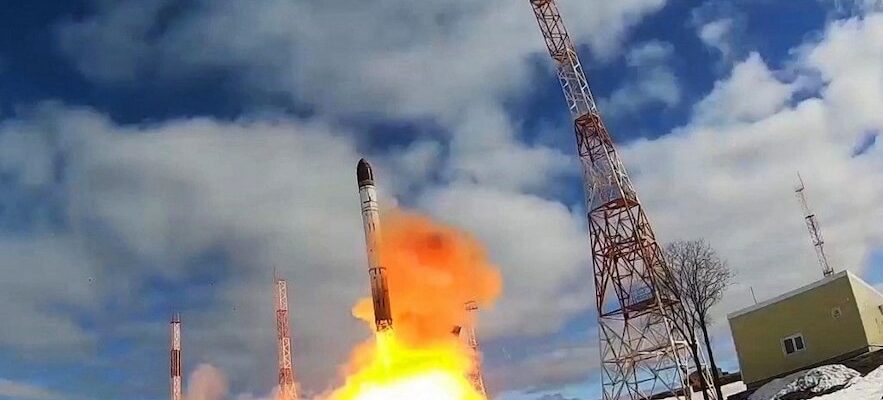The end of the Cold War had removed from the minds of Europeans the risk of apocalypse posed by nuclear weapons, which had long been part of their daily lives. The threats launched by the Russian president with the invasion of Ukraine have brutally reintroduced it. This is not the only symptom of a shift into a new era. The Russian-American bipolarity is being challenged by China, whose arsenal continues to grow in opacity. New “endowed” powers are emerging: North Korea, already; Iran if it decides, and other states, tomorrow, if they see it as the only way to ensure their survival. In 1964, the director Stanley Kubrick titled his satirical film Dr. Strangelove: How I Learned to Stop Worrying and Love the BombThis “mad love” has taken over the world and complicates the game of powers.
EPISODE 1 – Nuclear weapons, the bidding war: how Ukraine had to give up its bomb
It’s been three days since Russian tanks crossed the Ukrainian border. Fighting rages all the way to the suburbs of kyiv. In a carefully staged video released on February 27, 2022, Vladimir Putin addresses his Defense Minister, Sergei Shoigu, and his Chief of Staff, Valery Gerasimov, who are sitting a few meters away. With an impassive face, the president “orders them […] to put the Russian army’s deterrent forces on special combat alert.” “Understood,” Shoigu replies laconically, while the deadliest European conflict since World War II has only just begun.
Broadcast on channels around the world and picked up on social media, the exchange has caused dread. How far will Putin go? When he announced his “special military operation” in Ukraine, he promised “anyone who tries to hinder us” a “response” […] immediate”, which “will inflict consequences […] “never known”. In the shadows, in the United States, France and the United Kingdom – three nuclear-armed powers – the best deterrence specialists, as usual, dissect Putin’s latest statements, then compare their analyses.
For seasoned diplomats and military personnel, this rhetoric is part of a strategy of intimidation and seeks to arouse anxiety in Western public opinion. It does not mean that Russia intends to cross the red line. Satellite images taken of the sites where Russian nuclear warheads are stored – which Moscow knows are monitored – reassure them. No suspicious activity is detected there. “In fact, there are no changes in the Russian nuclear posture,” explains a former strategist of the French nuclear forces. “Putin, when he speaks, remains faithful to his doctrine.”
Blow hot then cold
This indicates, in a document published in 2020, that Russian nuclear weapons could be used if weapons of mass destruction are used against Russia or if “the very existence of the state” is threatened by military aggression. “There can be no winner in a nuclear war and it must never be started,” the Russian president repeated in August 2022, with the aim of appearing to be a responsible leader.
Photo released by the Russian Defense Ministry shows the test launch of a Sarmat intercontinental ballistic missile from the Plesetsk Cosmodrome, Russia, April 21, 2022.
© / Sputnik via AFP
Blowing hot, then cold. Vladimir Putin is pursuing a logic of reasserting Russian nuclear power, which has been escalated by the invasion of Ukraine. “This nuclear threat, which accompanies the continuation of Russian offensive activities, is the biggest change in the last three years,” says Rose Gottemoeller, the former US Undersecretary for Arms Control. It is restricting the West in its aid to kyiv – it took more than a year before German tanks were sent, more than two for F-16 fighters – and is keeping them from sending their soldiers.
They fear Russia’s use of a “tactical” weapon, designed for short-range targets on a battlefield, and less powerful than the warheads of an intercontinental missile. This is not just a fantasy. American intercepts have revealed that this use was discussed by Russian military leaders in the fall of 2022, according to the New York Timeswhen their army was pushed back from the Ukrainian regions of Kharkiv and Kherson. The coordinated action of Washington, China, India and Turkey on the costs of such an attack would have killed the project in the bud.
New nuclear missiles
Russia’s nuclear aggressiveness is also reflected in its way of communicating about the destructive means at its disposal. Russia continues to modernize the maritime and land components of its deterrent. It arms new ballistic missile submarines every year, while its latest intercontinental missile, the Sarmat – SS-X-30, according to NATO terminology – was commissioned in the summer of 2023.
Its leaders also boast of developing hypersonic missiles, capable of bouncing off certain layers of the atmosphere like the Vanguard, and even nuclear torpedoes. The United States has thus publicly expressed concern about the development of a space nuclear weapon with anti-satellite capability, which would violate the 1967 Outer Space Treaty. “Russia is returning to a logic of diversification of its weapons, as in the Cold War,” points out Héloïse Fayet, a nuclear specialist at the French Institute of International Relations.
A few weeks after the annexation of Crimea, President Barack Obama called Russia “a regional power that challenges its neighbors not because of its strength but because of its weakness.” This denial of great-power status was taken as an affront by Putin. “No one would talk to us, no one would listen to us,” he responded four years later, as he himself presented his new “invincible” nuclear weapons. Before adding, curtly: “Listen now.” Today, the Russian president got what he wanted.
.
